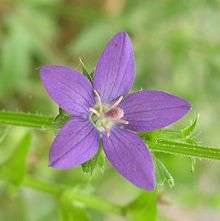Triodanis perfoliata
Triodanis perfoliata, the clasping Venus' looking-glass[2] or clasping bellflower, is a flowering plant belonging to the family Campanulaceae. It is an annual herb native to North and South America, the natural range extending from Canada to Argentina. It is also naturalized in China, Korea and Australia.[1][3][4][5][6][7]
| Triodanis perfoliata | |
|---|---|
 | |
| Scientific classification | |
| Kingdom: | Plantae |
| Clade: | Tracheophytes |
| Clade: | Angiosperms |
| Clade: | Eudicots |
| Clade: | Asterids |
| Order: | Asterales |
| Family: | Campanulaceae |
| Genus: | Triodanis |
| Species: | T. perfoliata |
| Binomial name | |
| Triodanis perfoliata | |
| Synonyms[1] | |
| |
Description
The flowers are wheel-shaped or bell-shaped and violet blue. They have 5-lobed corollas and are radially symmetrical. The leaves are 1/4–1" wide, are scallop-edged and shell-shaped. The plant is 6–18" high and flowers from May to August. It produces a small, many seeded capsule for fruit.
 Showing cordate-clasping leaves and a maturing capsule
Showing cordate-clasping leaves and a maturing capsule
Uses among Native Americans
The Cherokee take a liquid compound of root for dyspepsia from overeating, and take an infusion of roots taken and use it as a bath for dyspepsia.[8]
The Meskwaki use it as an emetic to make one "sick all day long",[9] and smoke it at ceremonies.[10]
| Wikimedia Commons has media related to Triodanis perfoliata. |
References
- Kew World Checklist of Selected Plant Families
- "Triodanis perfoliata". Natural Resources Conservation Service PLANTS Database. USDA. Retrieved 15 December 2015.
- Flora of China v 19 p 552, 穿叶异檐花 chuan ye yi yan hua, Triodanis perfoliata (Linnaeus) Nieuwland, Amer. Midl. Naturalist. 3: 192. 1914.
- Acevedo-Rodríguez, P. & Strong, M.T. (2012). Catalogue of seed plants of the West Indies. Smithsonian Contributions to Botany 98: 1–1192.
- Lammers, T.G. (2007). World checklist and bibliography of Campanulaceae: 1–675. The Board of Trustees of the Royal Botanic Gardens, Kew.
- Theiret, John (2001). "North American Wildflowers", Alfred A. Knopf Inc.
- Flora Bonaerense, Plantas y Hongos de la Provincia de Buenos Aires, Argentina, (Triodanis perfoliata)
- Taylor, Linda Averill 1940 Plants Used As Curatives by Certain Southeastern Tribes. Cambridge, MA. Botanical Museum of Harvard University (p. 60)
- Smith, Huron H. 1928 Ethnobotany of the Meskwaki Indians. Bulletin of the Public Museum of the City of Milwaukee 4:175–326 (p. 206)
- Smith, Huron H. 1928 Ethnobotany of the Meskwaki Indians. Bulletin of the Public Museum of the City of Milwaukee 4:175–326 (p. 272)